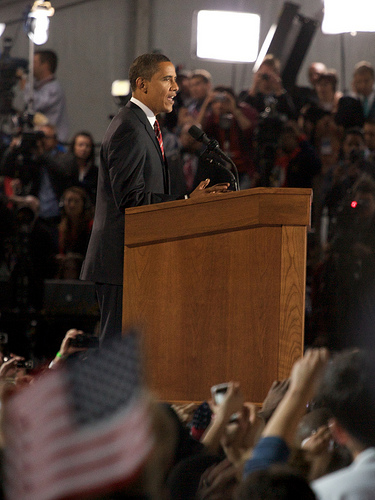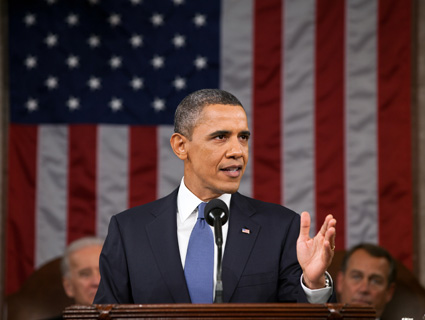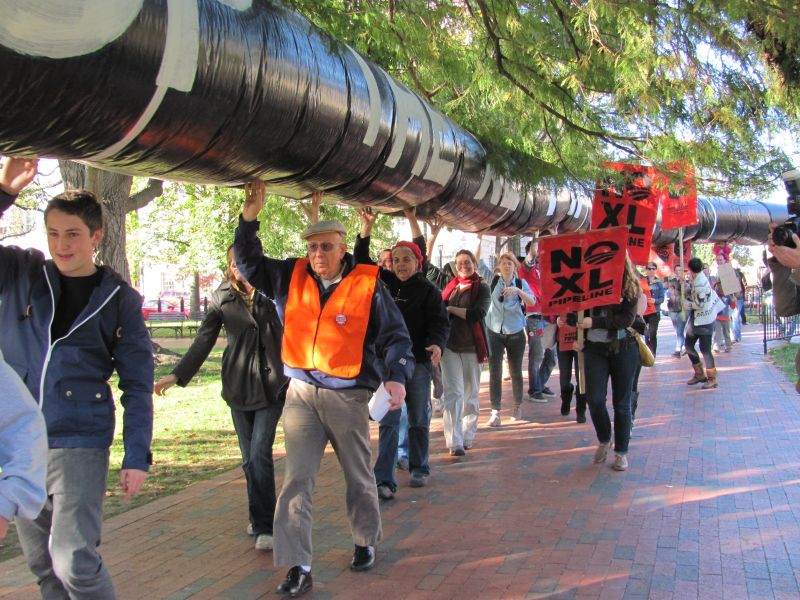
<a href="http://www.flickr.com/photos/bodhithaj/3004963362/sizes/m/in/photostream/">bodhithaj</a>/Flickr
President Barack Obama had a lot to say about energy at Tuesday night’s State of the Union address. The president mentioned the word 23 times in the course of the speech, but his emphasis was mostly on fossil-based energy. He focused the majority of his comments on expanding offshore and onshore oil and gas drilling.
Obama called for opening “more than 75 percent of our potential offshore oil and gas resources” to drilling. His only reference to the massive BP oil spill—which occurred just a few days after the last time he called for a major expansion of offshore drilling—was to argue that oil companies should be able to “contain the kind of oil spill we saw in the Gulf two years ago.” There was no mention of preventing those spills in the first place, however.
The president also called for expanded development of on-shore natural gas, and said that those who extract gas on public lands will be required to disclose the types of chemicals they’re using. And he called, once again, for a “clean energy standard”—a proposal that was included in last year’s speech but didn’t make much progress in Congress. “The differences in this chamber may be too deep right now to pass a comprehensive plan to fight climate change,” Obama said. “But there’s no reason why Congress shouldn’t at least set a clean energy standard that creates a market for innovation. So far, you haven’t acted.”
At least Obama supports recycling.
In the meantime, Obama said he is directing the Department of Interior to approve enough “clean energy” projects on public land to power 3 million homes. And he announced that the Navy plans to purchase enough clean energy to power a quarter of a million homes each year.
The energy portion of the speech is below the fold:
Nowhere is the promise of innovation greater than in American-made energy. Over the last three years, we’ve opened millions of new acres for oil and gas exploration, and tonight, I’m directing my Administration to open more than 75 percent of our potential offshore oil and gas resources. Right now, American oil production is the highest that it’s been in eight years. That’s right – eight years. Not only that – last year, we relied less on foreign oil than in any of the past sixteen years.
But with only 2 percent of the world’s oil reserves, oil isn’t enough. This country needs an all-out, all-of-the-above strategy that develops every available source of American energy – a strategy that’s cleaner, cheaper, and full of new jobs.
We have a supply of natural gas that can last America nearly one hundred years, and my Administration will take every possible action to safely develop this energy. Experts believe this will support more than 600,000 jobs by the end of the decade. And I’m requiring all companies that drill for gas on public lands to disclose the chemicals they use. America will develop this resource without putting the health and safety of our citizens at risk.
The development of natural gas will create jobs and power trucks and factories that are cleaner and cheaper, proving that we don’t have to choose between our environment and our economy. And by the way, it was public research dollars, over the course of thirty years, that helped develop the technologies to extract all this natural gas out of shale rock – reminding us that Government support is critical in helping businesses get new energy ideas off the ground.
What’s true for natural gas is true for clean energy. In three years, our partnership with the private sector has already positioned America to be the world’s leading manufacturer of high-tech batteries. Because of federal investments, renewable energy use has nearly doubled. And thousands of Americans have jobs because of it.
When Bryan Ritterby was laid off from his job making furniture, he said he worried that at 55, no one would give him a second chance. But he found work at Energetx, a wind turbine manufacturer in Michigan. Before the recession, the factory only made luxury yachts. Today, it’s hiring workers like Bryan, who said, “I’m proud to be working in the industry of the future.”
Our experience with shale gas shows us that the payoffs on these public investments don’t always come right away. Some technologies don’t pan out; some companies fail. But I will not walk away from the promise of clean energy. I will not walk away from workers like Bryan. I will not cede the wind or solar or battery industry to China or Germany because we refuse to make the same commitment here. We have subsidized oil companies for a century. That’s long enough. It’s time to end the taxpayer giveaways to an industry that’s rarely been more profitable, and double-down on a clean energy industry that’s never been more promising. Pass clean energy tax credits and create these jobs.
We can also spur energy innovation with new incentives. The differences in this chamber may be too deep right now to pass a comprehensive plan to fight climate change. But there’s no reason why Congress shouldn’t at least set a clean energy standard that creates a market for innovation. So far, you haven’t acted. Well tonight, I will. I’m directing my Administration to allow the development of clean energy on enough public land to power three million homes. And I’m proud to announce that the Department of Defense, the world’s largest consumer of energy, will make one of the largest commitments to clean energy in history – with the Navy purchasing enough capacity to power a quarter of a million homes a year.
Of course, the easiest way to save money is to waste less energy. So here’s another proposal: Help manufacturers eliminate energy waste in their factories and give businesses incentives to upgrade their buildings. Their energy bills will be $100 billion lower over the next decade, and America will have less pollution, more manufacturing, and more jobs for construction workers who need them. Send me a bill that creates these jobs.















